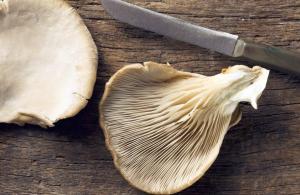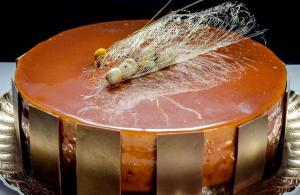X surgeons had to put a spacer in my sinuses to keep my brain in place while they removed all this tissue,” Ed Curry shares the details. He is 51 years old and is the kind of guy that almost everyone likes at first sight. He was a banker and now grows chili peppers. He has a minivan with the company name PuckerButt Pepper Co. on it. on board and an eternal smile on his face: he is happy to be alive.
The operation he is talking about was performed on him in 2007. After months of headaches and nosebleeds, Curry finally found out: he had a suspicious growth in his head that had tripled in size in a few weeks. Curry was concerned, to put it mildly: he had been diagnosed with cancer in the past. At one time, he had a malignant tumor removed from his arm, and later had surgery for thyroid cancer and three types of skin cancer. In general, the history is so-so.
Curry thought he would not survive the last operation. But when doctors sent samples of scraped tissue to the laboratory, it turned out that the tumor was benign. Why? In the refrigerator compartment of his minivan there are a dozen varieties of super-hot chili peppers. One of them, called the Carolina Reaper, was included in the Guinness Book of Records as the angriest pepper on Earth - 1,569,300 Scoville units (it is 157 times hotter than a jalapeño). “I think it's because I've been eating eight to 10 of these peppers every day for over a decade,” Ed says.

Where did it come from?
Edgy is in fashion today. It is estimated that about a quarter of all humanity consumes chili peppers daily. In the US, for example, chili imports have increased by 1,200% since the 1960s. And here, too, you’ve probably noticed: bottles of Tabasco on cafe tables are no longer a rarity. Shelves with all sorts of sriracha and other chili sauces can be found in any large grocery store. Well, real gourmets are offered a choice of more than 150 fiery mixtures - for example, in the Brooklyn establishment Heatonist. And all this suggests a unique feature of man.
Most mammals avoid hot peppers - they are scared off by the inevitable pain. And only we, people, got hooked on spicy things, inventing more and more fiery seasonings. Why? A possible root cause is that pepper helped (and helps) preserve food. Before the invention of the refrigerator, stomach upset due to fungi and bacteria growing in food was common.
However, as Paul Sherman, an evolutionary biologist from Cornell University (USA), says, early civilizations, especially in warm climates, noticed that spicy ingredients could neutralize these bacteria. Chili, cumin, garlic and a number of other tongue-burning seasonings destroy up to 75% of the most common pathogens of food poisoning. Thus, people developed a connection between “sharp and safe”, although this implied some unpleasant sensations.
Modern science is discovering new biochemical properties of pepper, which can lead to the emergence of specialized remedies for such ailments as chronic pain, obesity, depression, diabetes, and cancer. “Pharmaceutical companies have spent billions developing these drugs,” says Arpad Shallazi of Monmouth University Medical Center (USA), author of almost a hundred papers on the use of capsaicin for medical purposes. “In my estimation, research in this area has become perhaps the most expensive in the history of pharmacology.”
Pepperologist from the slums
In the distant past, Ed Curry ate haphazardly and took very little care of himself - despite a family history of cancer. And about 20 years ago I completely sank to the very bottom: I lived in Michigan, was a latent alcoholic and was caught driving drunk more than once. Divorce, depression, fast food, 170 kg. He tried to lose weight by drinking the SlimFit weight loss product with vodka. And when an angel came to visit him in the middle of the night, Ed packed his things and went to the nearest rehabilitation center.
After being discharged, he lived with one dream: to move to warmer climes and do the only thing he liked more than alcohol - growing chili peppers. Well, he once had such a hobby. Three years later, when the course of treatment ended, Curry left for South Carolina (it is warmer there than in Michigan). By 2001, he had lost weight to 84 kg. At one of the meetings of the Alcoholics Anonymous group, he met Linda and fell deeply in love.
Today they raise two children in a house surrounded by several hectares of fields where experimental varieties of peppers grow. Curry regularly donates the fruits of his work to scientists from a number of laboratories with which he has signed non-disclosure agreements. And overall happy.
Healthy pepper
Pharmacists are coming up with new acute medicines to...
- ...cauterize. headache According to the journal Neurology, nasal sprays with capsaicin reduce the sensitivity of the inflamed trigeminal nerve, relieving accompanying headaches.
- ...burn it out. back pain According to information published in Phytotherapy Research, a cream containing at least 0.075% capsaicin should help you.
- ...burn sinusitis. The University of Cincinnati (USA) found that capsaicin sprays help relieve pressure in the sinuses, bringing relief from sinusitis.

A burning panacea
Chemists began to find out why pepper burns at the beginning of the 19th century. And whatever the reason, scientists knew: it was concentrated in yellow oily droplets released from the walls of the pepper where the seeds were attached. They tried in different ways to isolate the purest form of the unknown substance, and finally, in 1846, the British chemist J.C. Tresh managed to obtain crystals without impurities, which he called capsaicin.
Capsaicin is an alkaloid, a close relative of other substances secreted from plants: caffeine, nicotine, morphine, etc. Already by the beginning of the 20th century, pharmacists invested quite a lot in research into the properties of such alkaloids - in the hope of patenting drugs based on them. And in line with all this scientific work, an employee of the pharmaceutical giant Parke-Davis, Wilbur Scoville, was tasked with assessing the hotness of different varieties of pepper. In 1912, he introduced his famous stinging scale, which showed the number of dilutions required so that the tongue no longer felt any burning sensation. The first record was set by the habanero pepper, which received 350,000 units.
Well, then off we go. The first cream containing capsaicin to massage aching muscles. The first “acute” warming ointment (and the mechanism of their action was not yet fully understood). The first theory is that humans have a receptor that reacts to capsaicin as something hot. Discovery of this receptor (TRPV1) and explanation of its operating principle. And endless attempts to find use for the physiological effects of capsaicin to treat a variety of diseases. Today it is known that hot peppers can potentially combat these unpleasant things.
1. Pain
In a nutshell: capsaicin binds to pain nerve receptors, constantly stimulating them (“burn”) until they “fizzle out” (subsequent numbness). So, in an experiment with dogs suffering from bone cancer, scientists injected the animals with resiniferatoxin (an alkaloid similar to capsaicin, but more powerful) in the hope of blocking the transmission of pain impulses to the brain. It worked: after a short period of extreme stimulation, the dogs' TRPV1 receptors burned out. And the dogs, who could not get up because of the pain, ran around again.
Several years ago, a program was launched in the United States to test resiniferatoxin as a pain blockade agent in cancer patients. Although the research is not complete, it is already clear that resiniferatoxin can selectively act on channels that transmit pain signals. This means that people with chronic pain will find relief.
2. Sadness
When attacked by capsaicin, TRPV1 receptors trigger a rush of pain-relieving (and mood-enhancing) endorphins. Which gives scientists reason to consider it as a potential means of combating depression. In one study, subjects were asked to chew a jalapeno and tell them when the burning sensation would stop. “At this point,” says Paul Bosland, head of the Institute for the Study of Chili Peppers at the University of New Mexico (USA), “they were injected with an endorphin blocker, and the burning sensation instantly returned.”
Thus, the connection between capsaicin and the production of endorphins was proven. Bosland suspects that endorphins explain the spicy cravings of guys like Ed Curry. “It looks like Pavlov’s dog,” he concludes. “You’re going to eat something spicy—the body releases endorphins in anticipation.”
3. Obesity
Capsaicin activates metabolism, making it easier to get rid of extra pounds. In South Korea, an experiment was conducted: three dozen obese women were given injections of either capsaicin or a placebo into their stomachs twice a week for eight weeks. Women in the first group had a greater decrease in body mass index, waist circumference, and waist-to-hip ratio than those in the second group.
It is known that metabolic rates decrease with weight loss - this was demonstrated by those who received a placebo. But those who received capsaicin avoided such trouble. Moreover, in laboratory mice, capsaicin neutralizes chronic inflammation caused by fat cells (this knowledge will help fight not only obesity, but also related diseases). However, all this is just a hypothesis, which has yet to be adequately applied in practice. In the meantime, doctors recommend maintaining metabolic rates while losing weight, primarily through physical activity.
4. Diabetes
“Epidemiological studies confirm that countries with high capsaicin consumption have lower incidences of diabetes,” says Andrew Dillin, a professor in the Department of Molecular and Cellular Biology at the University of California, Berkeley (USA). Scientists are close to unraveling the reason. Last year, Dillin published research suggesting a link between capsaicin, diabetes and longevity. As usual, the mice helped.
Scientists bred rodents without TRPV1 receptors (we can say that the mice were forever in the state that occurs when the “burn” from spicy food passes, that is, when the nerves are “exhausted”). The result: the organisms in this brood produced much less of a substance called CGRP, which interferes with the pancreas' ability to produce insulin. It appeared that mice lacking TRPV1 were immune to diabetes and obesity; their life expectancy was 14% higher.
5. Cancer
Not long ago, a group of scientists from the University of Toronto proved that taking capsaicin before radiation makes malignant tumor cells more sensitive to radiation (we were talking about prostate cancer). Relatively speaking, it “softens” them, making them easier to destroy. (It is not yet clear why Curry's new tumor turned out to be benign.) In 2014, scientists from the University of Alcalá (Spain) discovered that capsaicin successfully helps fight other types of cancer, including colon, pancreatic, liver, breast, although in each case it acts differently (in some cases it causes cell suicide, in others it breaks the tumor growth mechanism).
It is believed that capsaicin can be a powerful addition to other treatments, but not everyone agrees. Biologist Paul Sherman cautions that capsaicin may not be a double-edged sword: for example, mice whose skin was treated with capsaicin cream had a higher risk of developing cancer in the presence of an additional factor (ultraviolet light). What we're saying is that you should approach all this with caution. If capsaicin is as powerful as scientists believe, then - like all drugs - it can be harmful if used incorrectly. Overdose is a serious matter.
Tears of happiness
So, how's Ed Curry doing? The old persedler drives around in his minivan to television studios, where he is invited to talk about his farm and hot new products. For example, about the experimental variety HP 56 (high power, super sharp, and the number is the serial number of the variety; in total, Ed cultivated more than 70 of them). HP 56 is almost twice as sharp as the Carolina Reaper, which means it will soon be included in the Guinness Book of Records. The climax of any such TV show is when Ed puts the whole pod in his mouth and calmly chews it. Only tears appear in Ed's eyes - but no one doubts that these are tears of joy.
Why does it burn
A comprehensive answer to a question that you have probably asked yourself more than once.

1. You're chewing chili peppers
When you bite into a pepper, you release concentrated capsaicin from its placenta. This chemical hits the TRPV1 receptors on your tongue, sending a burning message down the neurons to the brain. And that, in turn, triggers a response: the release of endorphins into the blood and sweating.
2. The mouth says: “Fire!”
Your TRPV1 receptors are attacked by capsaicin molecules, which bind to nerves, causing a rush of calcium ions into surrounding cells. Now your body considers it pain (such a chemical hoax). Drink milk: the casein it contains coats capsaicin and removes it from the body.
Hot chili pepper first appeared in Europe in the 15th century, and the first person to try this product was Christopher Columbus. It was he who appreciated the piquancy of American Indian food. By the way, the name of the pepper has nothing to do with the country of Chile and its spiciness.
Chili is the name of the Aztec language. The main benefit of pepper is not its spiciness, but the fact that it can positively influence the functioning of the gastrointestinal tract, promote weight loss and cure sore throats.
When talking about chili peppers, the first thing you think of is a red product that has relatively recently found its way into many kitchens. Although chili is not necessarily a red pepper, it can be green or orange, and the heat will depend on the ripeness and variety of the vegetable. But, of course, the most piquant is considered to be the mature red capsicum (the so-called capsicum).
Its benefits will “fill” the body with vitamins and enzymes that will help support the immune system and cure several diseases. Scientists have proven that red chili can cure diabetes, infectious diseases and lower blood pressure.
As many as 5 diseases can “give up” under the influence of vegetables:
- Do you suffer from high blood pressure? Red pepper contains trace elements and antioxidants that affect the blood supply system, dilating blood vessels and normalizing heart function. If you include hot peppers in your diet and consume them once a day for a week, you will notice that your blood pressure has dropped and your general condition has improved.
- The benefits of the product will be appreciated during a cold or acute infectious disease. About 80% of malicious microbes and bacteria will die when interacting with the juice of this hot pepper. You can use the red pod for infectious sore throat, intestinal upset or poisoning.
- Researchers who study how red pepper affects the body say it reduces the risk of cancer by 90%. True, there is no direct scientific evidence of this fact, but statistics show that residents of Latin America who consume large quantities of this product are less likely to suffer from cancer.
- The red vegetable is rich in folic acid, beta-carotene and riboflavin - these substances help strengthen the nervous system.
- The vegetable also benefits from the presence of vitamins A, C and B, which strengthen the immune system. Scientists have confirmed the fact that people who regularly consume chili peppers have strong immunity. This is due not only to the amount of vitamins in the vegetable, but also to its ability to disinfect the intestinal tract.
And another benefit of the product is its ability to treat psoriasis, arthritis and diabetes. Modern medical preparations include an extract of this hot pepper. Red pepper is also used as a means for effective weight loss. It contains enzymes that suppress appetite, and the hottest Habanero variety can be used as an effective laxative.
The benefit of pepper also lies in its effect on the liver - capsicum is able to restore it at the cellular level. If you have liver disease, you can safely include this red vegetable in your diet.
And, of course, the well-known benefit of the product is its ability to cure bronchitis and colds, especially if you use mustard plasters and tinctures made specifically from the red legume vegetable.
Three myths and one truth about the dangers of pepper
Along with the benefits of this leguminous vegetable, scientists have been arguing about the dangers of pepper for many years. Some talk about its ability to cure many diseases, while others say that its pungency harms the delicate gastric mucosa.
 Should you eat red pepper or not? Let's debunk the most “inveterate” myths.
Should you eat red pepper or not? Let's debunk the most “inveterate” myths.
- This vegetable causes ulcers and gastritis. Of course, capsicum can be harmful if consumed in large quantities. But, if you add the product to food in small portions, then red pepper juice will not be able to attack the walls of the stomach, because every day they are exposed to even greater influence of their acids. But pepper can cause significant harm if you already have gastritis or an ulcer in the acute stage.
- Chili peppers cause cancer. Scientists who studied the harm of the product tried to prove that the abuse of pepper can cause stomach cancer. In general, they tried and tried, but they proved the opposite. The research was conducted in Mexico City, where people eat 2-3 pods of the vegetable every day. So, out of 10 thousand, only two people had a malignant tumor. For comparison, in Europe, where they consume no more than 1 pepper per week, this figure was 16-19 people. Scientists were unable to prove “cancerous” harm; now researchers are finding out the positive effect of the product on cancer cells.
- There is an opinion that drugs that are made on the basis of a hot vegetable can harm the nervous system and cause addiction. There is an opinion that red pepper is a narcotic substance. This myth was the result of word of mouth, since strong painkillers were indeed created, but they have nothing to do with pepper. Chili will not be able to harm the nervous system, much less cause addiction.
The only real harm that a red vegetable can cause is damage to the mucous membrane of the eyes.
Contact with particularly hot pepper varieties can cause burns. So you just have to take precautions. You should not overuse this spicy product, so as not to “overwork” the gastric mucosa. The daily intake of red pepper should not exceed 15 g (one tablespoon) per day. As for calorie content, 15 g is about 5 calories, so the product can really be called dietary.
Can you die from eating hot peppers? November 2nd, 2016
The most wonderful burning sensation after a delicious curry or salsa is a fiery blessing that will leave you sweating and blushing. For many people this is one of the greatest pleasures in life. And the search for the spiciest dish becomes not only a hobby, but an obsession. We even had a post about
Fans of spicy foods feel completely safe knowing that even though capsaicin, an alkaloid found in hot peppers, irritates the pain neurons in the mouth, causing a burning sensation, it does no real harm. After a few minutes, the feeling like you've set your mouth on fire will go away. This all seems more like simple fun, doesn't it?
At least until someone gets hurt.
Hot pepper eating competition in China. Photo by Reuters
Hot peppers are classified according to their level of heat, measured in Scovilles. The degree of spiciness begins to be measured from the bell pepper (0), to the pepper with a rather scary name - the Carolina Reaper (2.2 million). And if daily consumption of a small amount of pepper does not cause any harm, then thrill-seekers have not had the most pleasant experience in this matter. In 2014, journalists from The Argus, a British newspaper, decided to taste burgers that were highly rated on TripAdviser. They both just took a bite of a burger with a huge amount of hot sauce made by the chef with the goal of scoring higher on the Squawville scale than pepper spray.
“The pain was so unbearable that one of the reporters immediately drank huge amounts of milk in an attempt to numb it,” the newspaper writes. The other one began to have severe pain in his stomach, he stopped feeling his own hands and began to choke. His colleague, despite all his attempts, also did not escape a similar fate, and they were both hospitalized. One said: “I was in so much pain I thought I was dying.”
The bravest spicy lovers who dared to eat the hottest types of pepper on camera could not stop themselves from vomiting. "A short YouTube video featuring a hot pepper eating contest is not a pretty sight," writes Aaron Thier for Lucky Peach. He watched a slow-motion recording of a Danish event where a thousand people ate hot peppers.
Matt Gross writes on his Bon Appetit account: “It took me 21.85 seconds to eat 3 Carolina Reapers, the hottest pepper in the world. And then it took me 14 hours to recover from the consequences” (Spoiler: the consequences included symptoms of a heart attack).
What's really going on here? If the only thing pepper can do is make us feel a little fire in our mouth, then why does it cause such a reaction in our body?
Let's look at the basic composition of capsacin. This alkaloid evolved as an antifungal agent for the plants in which it was found. But when a person consumes this pepper, certain neurons responsible for the perception of pain are activated. These neurons send a message about the sensation of heat to the brain, regardless of whether the burning sensation is caused by an actual burn or a pepper. The list of tasks of neurons does not include searching for differences between these harmful phenomena; it is better to deal with this now than to suffer even more later.
The physical effects of eating pepper can be considered by our body as actual burns. Accordingly, sweating is our body’s attempt to cool itself. Certain neurons release substances that cause vasodilation, which leads to inflammation, which means that the best thing to do is to deliver blood to the damaged area, and thus the body provides first aid to itself.
When the Carolina Reaper attacks the gastrointestinal lining, you will experience gagging as this is a response from the nerve endings in the stomach. The body seems to say: “I don’t care whether it’s a burn or pepper, I’m going to get rid of it.”
Thus, the body's reaction to capsaicin is similar to the reaction as if you ingested a caustic substance. That is, the neurons in your mouth, stomach and other organs will act, and they don’t care whether what you swallow is going to kill you or just cause discomfort.
But be that as it may, eating pepper will not cause long-term harm to your health. However, biologists conducted an experiment during which they injected doses of capsaicin into young mammals, which caused the death of neurons responsible for the perception of pain. Repeated irritation of neurons seems to wear them out, and they simply do not grow back.
Interestingly, there is even a theory that peppers secrete capsaicin to deter mammals from eating their seeds. And the birds that spread these seeds simply don't have the receptors to feel the burning sensation. But apparently, man is a mammal with an absolute lack of common sense.
Luckily for pepper, humanity hasn't done much harm to his well-being.
Why do people love spicy food?
Indeed, when consuming spicy food, endorphins, hormones of joy, can be released, but their participation in the formation of a preference for spicy food is just an unconfirmed hypothesis. Social factors and the habit of eating spicy foods are much more important. Compare the level of spiciness in Indian and Mexican cuisine with Italian, for example. Mexicans do not release more endorphins than Europeans, they are simply accustomed to spicy foods from childhood. If the mechanism were as simple as the release of “happiness hormones,” we would all be on chili peppers, like cocaine.
sources
It's no secret that cooking is simply fashionable today. This is facilitated by TV programs with the participation of stars who are literally bombarded with a variety of tempting recipes. So lovers of Mexican or other cuisine, the dishes of which contain hot peppers (chili or other varieties), also prefer to cook their favorite dishes themselves. But it is unlikely that a person who does not have a special culinary education can imagine that one can get a serious burn when cutting hot peppers.
Usually, we don’t think about safety precautions in the kitchen when cutting hot peppers, and we neglect basic protection of the skin of our hands, for example. Moreover, pepper burns on the oral mucosa are common if you are not careful when consuming hot peppers. You need to be careful not only when preparing food and while eating, but also when harvesting this spicy vegetable. Burns can also be caused by incorrect use of pepper plaster, as well as by incorrect application of locally irritating masks in cosmetology.
Why do hot peppers burn or how does capsaicin work?
Meanwhile, such an injury as a burn from red pepper, as well as green pepper, is quite understandable. The fact is that chili pepper contains an active substance that gives it its hotness. It is called capsaicin or 8-methyl 6-nonenoic acid vanillyl amide, which is a fairly stable chemical compound. This fatty acid, which is part of hot pepper, does not have a distinct color and has a burning taste. It should be noted that capsaicin does not dissolve in alkaline water-based solutions. That is, if you are looking for a remedy for a pepper burn and come across a recommendation to treat it with soda dissolved in water, you are unlikely to succeed. But the active substance of chili pepper can be easily dissolved in organic solvents, fats or ethyl alcohol.
How to avoid
The well-known proverb “God protects those who are careful” perfectly reflects the essence of prevention against pepper burns. When using pepper in food preparation, latex gloves must be used to avoid injury. The same should be done when harvesting all hot and bitter types of peppers.
If you are preparing a spicy dish wearing special gloves, then you should not rub your nose or eyes with your sealed hands, or even touch other exposed areas of the skin. And in order to protect the mucous membrane and prevent burns, you do not need to use this seasoning in large quantities.
But what to do if the skin is burned by the active substance contained in hot, bitter and hot peppers? This question torments several million people who have already found themselves in a similar mess. First of all, remembering the nature of capsaicin (an organic fatty acid), the burn site should be smeared with salt slightly moistened with water, which after a while will need to be washed off with milk. In this case, for a burn, we use salt as an alkali and milk as fat, which also dissolves capsaicin well.
If you are lucky enough to eat a large, fiery slice of Mexican Torta Paulista, then given the good solubility of the active substance of red pepper in alcohol, you can drink a little alcohol. You can also take a sip of vegetable oil or another fatty drink, such as yogurt, milk or cream, to reduce the burning sensation. They say that eating a cucumber, a spoonful of honey, a pinch of salt, a slice of bread or a glass of ice cream can help with the consequences of swallowing an excessive amount of hot pepper.
But, despite the variety of popular advice, doctors recommend treating the pepper burn with a spray containing lidocaine. This should only be done if there are no contraindications. Very rarely, pepper burns can cause complications such as nausea, corneal damage, or breathing problems. You may also experience: dermatitis, nosebleeds or even neuralgic disorders. Therefore, immediately after you have relieved the pain with a spray, you should definitely go to see a doctor.
In order to avoid hand burns from pepper , the collection and processing of peppers should be approached with caution and done with latex gloves. And in order to avoid the need to treat the mucous membrane with painkillers, spicy dishes containing hot peppers are best eaten carefully, washed down with small amounts of alcohol, for example. And if you have sensitive mucous membranes, then it is better to abstain from such food altogether.
Evgeny Shmarov
Reading time: 7 minutes
A A
Today, about 30 varieties of chili pepper are known in the world, which is a fiery and pungent vegetable used in cooking mainly for preparing various spices and seasonings.
Chili peppers were brought to Europe by Christopher Columbus along with tobacco, beans and other vegetables. And this type of pepper is not called this way at all in honor of the country of Chile, it’s just that in the Aztec language the word “chilli”, from which the name of the vegetable originated, means “red”.
Chili Pepper Varieties and Nutritional Values
Chili peppers are actually called capsicum species of the genus Capsicum annuum.
There are several classifications of chili pepper types. The first of them is according to the pungency scale, which was proposed to us by the American chemist Wilbur Scoville.
Based on the data on this scale, chili peppers are:
- Weakly burning.
- Medium hot.
- Very hot.
The pungency determines the amount of capsaicin contained in the vegetable. Sometimes its content reaches 1.5 million units (for example, in Carolina Reaper pepper).
The classification of chili peppers according to the most popular varieties is more relevant
Bird's eye. This chili pepper is popular in Mexican, Oriental and African cuisines. It is very sharp, has a bright red or deep orange color and an oblong, angular shape.
Poblano. The pepper is medium hot, round in shape and large in size. In cooking, poblanos are mainly used baked or served with smoked meats. Has a rich green color.
Habanero. It is considered the hottest among all types of chili peppers. Habanero is the main component of the famous Tabasco hot sauce. Externally, this species is similar to sweet bell pepper - it is slightly wrinkled, very fleshy, has a round shape and a rich aroma. Habanero has several color options - red, yellow, bright orange and light green.
Serrano. This chili is easy to distinguish from other types of pepper due to its bullet-like shape. Serrano is characterized by medium heat, which is why it is actively used to prepare various sauces. It has a dark green or dark red color.
Jalapeño. The most popular chili pepper in Mexico. The vegetable has a green color, which changes to dark red as it ripens. In cooking it is used both in unripe and ripe form. Jalapeño goes well with various meat dishes and almost all types of cheese.
Anaheim. This type of chili pepper is often used in a spicy spice known to us all as curry. Anaheim vegetables are large and oblong peppers with an aromatic and mild flavor. In cooking, Anaheim pepper goes well with legumes and rice, to which it imparts incredible heat, as well as with meat and vegetable dishes.
Nutritional value of 100 g chili pepper:
100 g of hot chili pepper contains 40 calories.
2 g – Proteins.
8 g – Carbohydrates.
0.2 g – Fats.
1.5 g - Dietary fiber.
87.8 g – Water.
5.1 g - Mono- and disaccharides.
0.6 g – Ash.
Vitamins contained in chili peppers:
1 mg ‒ Vitamin PP.
0.67 mg - Beta-carotene.
59 mcg ‒ Vitamin A.
0.09 mg ‒ Vitamin B1.
0.09 mg ‒ Vitamin B2.
0.28 mg ‒ Vitamin B6.
23 mcg - Vitamin B9.
243 mg ‒ Vitamin C.
0.7 mg ‒ Vitamin E.
14.3 mcg – Vitamin K.
11.1 mg – Choline.
Macro- and microelements contained in chili peppers:
18 mg – Calcium.
25 mg – Magnesium.
7 mg – Sodium.
340 mg – Potassium.
46 mg – Phosphorus.
1.2 mg – Iron.
0.3 mg – Zinc.
174 mcg – Copper.
0.24 mg – Manganese.
0.5 µg – Selenium.
Benefit
Chili pepper is not only a favorite vegetable for fans of spicy dishes, but also an incredibly healthy culinary ingredient.
Benefits of chili pepper:
- The first thing any doctor or nutritionist will tell you is that chili peppers are a strong antioxidant, and therefore beneficial for many of us.
- This type of pepper has a laxative effect, which is why chili is recommended to be consumed in any form by people suffering from constipation and flatulence.
- It has a beneficial effect on the processes of the digestive system as a whole, stimulating the functioning of the stomach. This allows you not only to enjoy delicious dishes, but also to lose weight.
- Chili is a product that helps increase the elasticity of blood vessels.
- Hot pepper also has thinning properties, so it is recommended to be used for hypertension, because it perfectly lowers blood pressure, and for people prone to blood clots.
- Doctors recommend consuming chili to prevent cancer.
- During a cold, chili pepper helps get rid of infections in the shortest possible time and promotes rapid recovery.
- Improves appetite and metabolism in the body. In addition, it has a beneficial effect on the functioning of the human brain, improving memory, concentration and attentiveness.
- After eating chili peppers, the body produces endorphins, which help get rid of insomnia, pain, reduce stress, and also improve the condition of epilepsy, hepatitis, allergies, asthma, and atherosclerosis.
- Chili strengthens the nervous system, so its use helps to quickly cope with any depression.
- In folk medicine, chili is used as a warming product. Thanks to this property, compresses with this type of pepper help to recover from diseases of the respiratory system - sore throat, bronchitis, pneumonia.
- Due to the fact that chili pepper accelerates the metabolic process, it can improve a person’s condition in case of poisoning, quickly ridding the body of harmful toxins.

This is interesting!
Scientists have proven that regular consumption of chili peppers reduces the risk of diabetes. Moreover, chili peppers are added to medications for the treatment of psoriasis and arthritis.
Harmful properties and contraindications
The main rule of eating chili is moderation. In large quantities, this product can be dangerous to your health!
Rules for eating chili:
- Chili pepper, like all very spicy foods, should absolutely not be consumed by those who have problems with the gastrointestinal tract, since chili can irritate the mucous membranes and provoke pain.
- Moreover, even when preparing dishes with hot chili added, you should not touch your eyes and nose with your hands.
- It is also worth preventing pepper from getting into open wounds - this will provoke an exacerbation of the inflammatory process, and healing will take a long period. For example, if pepper seed oil gets into a wound, it may cause a skin burn. And if you didn’t calculate it correctly and ate a lot of chili pepper, then a burn to the oral mucosa is possible.
On a note! Some foods will help cope with the burning sensation - milk, yogurt, cold ice cream or clean drinking water. You can also eat a piece of fresh bread, a small amount of boiled potatoes or rice. All of these products perfectly absorb capsaicin, which causes a burning sensation in the mouth.
Chili in the diet - doctors and nutritionists answer questions
Despite the beneficial properties and rich vitamin composition of chili pepper, there are categories of people who should not consume it in any form, or should consume it in very limited quantities.
Should children be given chili?
Pediatricians allow children to eat mildly hot chili peppers starting at the age of 12-13. Until this age, the mucous membrane of babies is too sensitive to capsaicin, so it is almost impossible to avoid burns.
Can pregnant women eat chili peppers?
Since pregnant women are not recommended to use spicy, fiery foods, chili peppers can only be eaten with the permission of an obstetrician-gynecologist. Because this type of pepper stimulates contractions of the uterine muscles, it can trigger premature labor.
Chili pepper for diabetes
If you have diabetes, you can eat chili peppers. It has a beneficial effect on well-being, as it helps normalize excess weight and lower blood pressure, which is always elevated in almost every diabetic. And due to the fact that chili is an excellent blood thinner, diabetic patients minimize the risk of blood clots.
Can I eat chili if I am allergic to any other type of pepper?
If you are allergic to or any other pepper, you should be careful when eating chili peppers. The fact is that the vitamin and mineral composition of all peppers is similar, and differs only in a small amount of one or another substance. That is why, if a person is allergic to at least one type of pepper, all others should be consumed with caution and under the supervision of a doctor.
How to select, store and cook chili peppers
When purchasing raw chili, the first thing you should pay attention to is its appearance. The pepper must have smooth, dense skin, without cracks or wrinkles. The color of the chili should also be uniform and free of blemishes.
On a note! If there are yellow or orange round dots on the product, it is better to refrain from such a purchase. Spots on chili peppers indicate that they were either treated with chemicals during ripening to ward off pests, or have already been exposed to them.
Chili can be stored dry for a long time. The pepper itself can remain whole or be ground into powder. Before using dried whole peppers for food Cooks recommend pre-soaking it in warm water for half an hour.
Dishes with hot chili peppers
Chili pepper is used both as a fresh vegetable in various culinary recipes, and in dried, ground form as part of various seasonings, flavorings, and spices.









